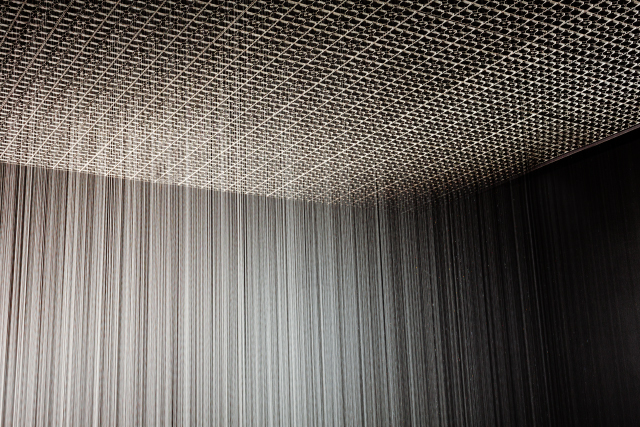There are many different roots one can go when deciding on an installation piece; the artist must come up with theme, location, and objection. He/she must determine the reaction and experience they want their audience to gain from the art piece. Installation art in principal is taking a large area and changing its perspective by filling it with art that constitute a whole other meaning to the original space.
The Weather Project and Rain Room are two experimental installation projects that follow a similar theme however have completely different features and objectives. Both pieces utilize the concept of weather they focus on specific aspects of the environment and the essence of exploring humanity within it.
The Weather Project installation created by Olafur Eliasson, focuses on creating a representation of the sun and sky. A thin mist slowly encases the space, through out the day the mist transforms into a cloud-like formation before is disperses across the installation. The light from the sun in contrast becomes produces a mono-frequency the lamps used emit a light in a very narrow frequency that only the colours yellow and black can be seen, this effect transforms the installation into a spectacular experience encompassing the sun.
The Rain Room created by artist Hannes Koch is experimental installation that depicts the essence rain with the use of water falling. The installation enables the audience to control their own root through the downpour without being soaked by water in the process. The installation follows movement and presence the general idea is that one can navigate them selves through a downpour without getting wet therefore feeling as if the user were one with the environment.
Both installation projects maintain a similar concept by focusing on the essence of the environment, aspects that have a relevant part in their art projects are to do with management, budget, scheduling and overall project objectives. The two projects require a large interior space for their installation; The Weather Project has a still experience where the centerpiece maintains the same coordinates while the Rain Room utilizes the whole space and maintains a consistent life-cycle, regardless of when the audience enters the art piece the installation will be the same. The experience for The Weather Project will differ depending on when the audience enters the installation. Both projects maintain powerful user experiences however exhibit it differently. The projects must consider budget when creating their pieces both installations require a large amount of maintaining in order to keep the installation sustained and natural.

Hej kendra, I’m not 100% sure which projects you refer to, can you add links to the original posts on OSS of the two projects?
It’s nice that you point out that both installations deal with rain and by extension the outdoor environment, while being indoor experiences. As a creative-mental exercise (!), can you imagine what the inverse might be? an indoor experience taking place outdoors…..
Details, I’m curious: Can you explain what you mean by “objection” that the artist comes up with?
Also, I think I grasp “control their own root” but can you fill out the details? What is happening in the installation, how are people controlling something, and what might be their reaction?
In terms of project management, which project do you think is more complex? more expensive?
This is a good comparison because the two projects are bringing up the theme “weather”. However, there should be a comparison between cost, time spent one planning, executing and the size of the space. A good planning should take the above-mentioned into consideration. However, I think the Rain Room might have taken more time when it comes to installation. The artist uses the strings as the element, seems like it needs a lot of time to install. For the budget aspect, I guess The weather project has spent more than the Rain Room. It uses monofrequency lights, projection foil, haze machines, mirror foil, aluminium, and scaffolding. The technology needs maintenance, hence it’s it might be more costy.
Good points, and justification for the assumption of higher costs for Rain Room due to the specialised equipment, which is relevant both for acquisition (or rental) and maintenance during an exhibition.
Hi Kendra, I agree with the comparison that you brought up in your post. However, the comparison about project planning might be lacking in your post.
I think i agree with Permagnus’ that there needs to be more comparison in terms of the details in planning and budget.
it’ll be good if you provide more information or links to the project.
Well, I feel art installations is about changing the visitors experience and of course you’re right, changing the perspective as well. I feel the comparison is quite limited here however I do agree that art installations in general have to consider when there is no one in there or whenever there is people. It changes the meaning of the work as well.